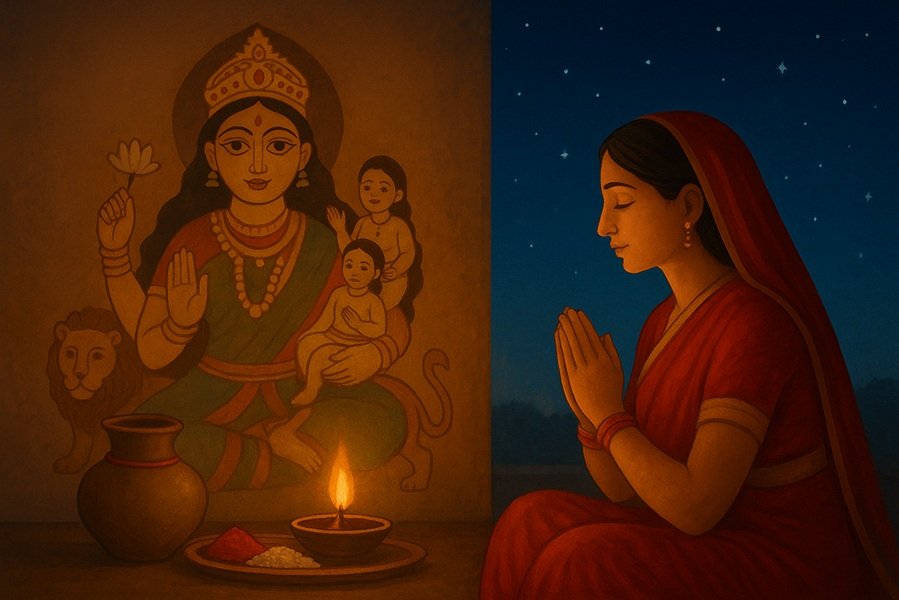
Ahoi Ashtami 2025 Date and Timing
- Ahoi Ashtami Date: Monday, October 13, 2025
- Ahoi Ashtami Puja Muhurat: 05:53 PM to 07:08 PM
- Duration: 1 Hour 15 Minutes
- Sighting of Stars (Sanjh): 06:17 PM
- Krishna Dashami Moonrise: 11:20 PM
- Ashtami Tithi Begins: 12:24 PM on October 13, 2025
- Ashtami Tithi Ends: 11:09 AM on October 14, 2025
- Govardhana Radha Kunda Snan: Monday, October 13, 2025
What is Ahoi Ashtami?
Ahoi Ashtami is a sacred Hindu festival celebrated primarily by mothers who observe a fast (vrat) for the health, prosperity, and longevity of their children. The festival falls on the Ashtami Tithi (eighth day) of the Krishna Paksha (waning phase of the Moon) in the month of Kartika, eight days before Diwali.
Ahoi Ashtami is also known as Ahoi Aathe, referring to the eighth day of the lunar month. The day is dedicated to Goddess Ahoi Mata, an incarnation of Goddess Parvati, who blesses devotees with progeny, good fortune, and happiness in family life.
Significance of Ahoi Ashtami
The celebration of Ahoi Ashtami has deep emotional and cultural importance among Hindu women, especially in North India — in regions like Uttar Pradesh, Delhi, Haryana, Punjab, and Rajasthan.
- For mothers: The fast is kept for the well-being, long life, and prosperity of their sons and daughters.
- For expectant mothers: It is believed that observing the fast blesses them with a healthy and virtuous child.
- Spiritual significance: The festival symbolizes repentance, devotion, and the maternal bond of love and care.
- Religious importance: Ahoi Mata is worshipped with full devotion, and her blessings are sought to remove obstacles and ensure the longevity of children.
Ahoi Ashtami Puja Vidhi (Rituals and Worship Method)
1. Early Morning Preparations
- Devotees wake up early, take a holy bath, and clean the house.
- The women observing the fast abstain from food and water (nirjala vrat) throughout the day.
- The place of worship is decorated with flowers and rangoli.
2. Drawing or Installing Ahoi Mata
- Traditionally, Ahoi Mata’s image is drawn on a wall using geru (red ochre) and rice paste or worshipped using a printed picture.
- The image depicts Ahoi Mata with her children and wild animals, symbolizing fertility and protection.
3. Offerings and Puja Samagri
- Puja thali items: Water-filled kalash, rice, roli, diya (lamp), sweets, fruits, and silver Ahoi symbol if available.
- Offerings to Ahoi Mata: Milk, rice pudding (kheer), and grains of wheat are placed before the goddess.
- Threads (Ahoi Mauli): A sacred red thread is tied around the kalash during the puja.
4. Evening Puja and Star Sighting
- The main puja is performed during the evening twilight (Sandhya Kaal) after the appearance of stars.
- Mothers gather in groups or with family members to perform the puja.
- Ahoi Ashtami Katha (story) is read or narrated.
- After sighting the stars and offering arghya (water offering) to them, the fast is concluded.
Ahoi Ashtami Vrat Katha (The Legend Behind the Festival)
Once upon a time, a woman living in a village went to dig soil for decorating her home for Diwali. While digging, she accidentally killed the offspring of a lion or a hedgehog (according to different versions). The mother of the baby cursed the woman that she would lose her children.
As a result, all her sons died one by one. Distraught, the woman confessed her sin to the villagers, who advised her to pray to Goddess Parvati. The compassionate Goddess blessed her and told her to observe a fast on Ashtami day and worship Ahoi Mata.
The woman followed the divine instructions and fasted with full devotion. Eventually, she was blessed with sons again, and her family prospered. Since then, women observe Ahoi Ashtami Vrat every year, seeking protection and blessings for their children.
Ahoi Ashtami and Govardhana Radha Kunda Snan 2025
On Monday, October 13, 2025, along with Ahoi Ashtami, devotees also perform Radha Kunda Snan — a sacred bath at Govardhan’s Radha Kunda in Mathura, Uttar Pradesh. It is believed that taking a holy dip in Radha Kunda on this day brings immense spiritual merit and fulfills all desires.
According to tradition, this snan (holy bath) cleanses sins and helps attain divine grace equivalent to performing thousands of yajnas.
Ahoi Ashtami Fasting Rules
- The fast begins at sunrise and ends only after sighting stars in the evening.
- Some devotees choose to break the fast only after moonrise.
- Grains, salt, and water are strictly avoided during the fast.
- Devotees can eat fruits or milk before starting the fast (known as parana).
- Women listen to or recite the Ahoi Mata Vrat Katha with faith and devotion.
- The fast is concluded after sighting the stars and offering prayers to Ahoi Mata.
Ahoi Ashtami and Karwa Chauth Connection
Ahoi Ashtami comes approximately four days after Karwa Chauth. While Karwa Chauth is observed by married women for their husbands’ long life, Ahoi Ashtami is kept for the welfare of children. Both festivals highlight the strength, love, and devotion of women in Indian culture.
Spiritual Beliefs and Benefits
- Ensures longevity and prosperity of children.
- Removes past sins related to harming life unknowingly.
- Brings peace and happiness to the family.
- Fulfills wishes for progeny for childless couples.
- Enhances spiritual purity through fasting and devotion.
Conclusion
Ahoi Ashtami 2025, falling on Monday, October 13, is a powerful festival of maternal devotion, repentance, and divine blessings. By observing this vrat with sincerity, mothers invoke Ahoi Mata’s grace for the well-being and prosperity of their children.
As the stars twinkle on the evening of Ahoi Ashtami, the prayers of countless mothers rise to the heavens — a symbol of unconditional love and timeless faith.
Read This: Atla Tadde 2025: Significance, Rituals, and 50+ Captions & Wishes




